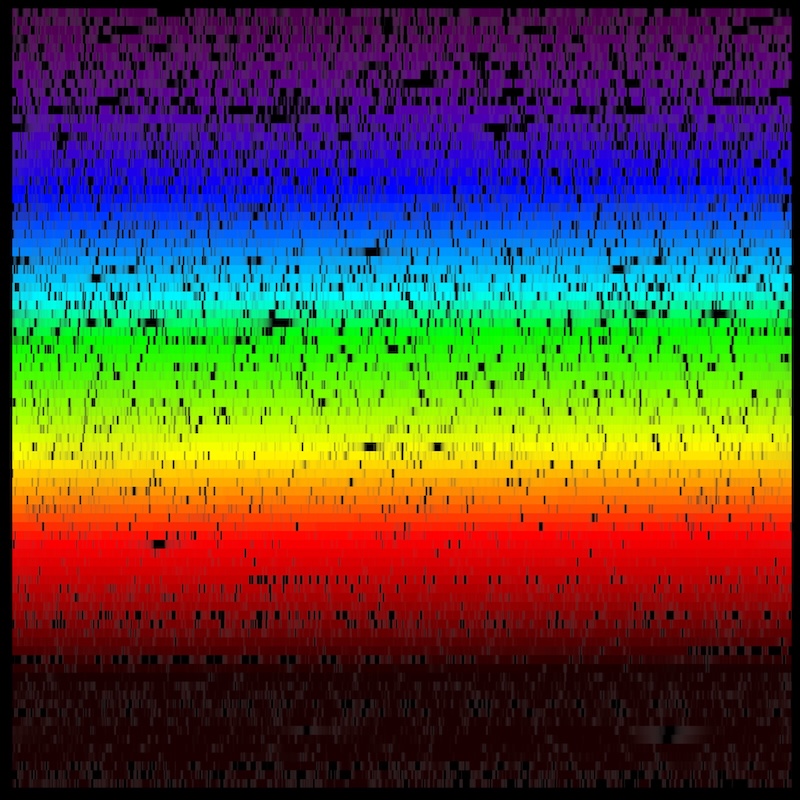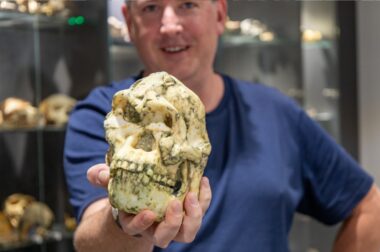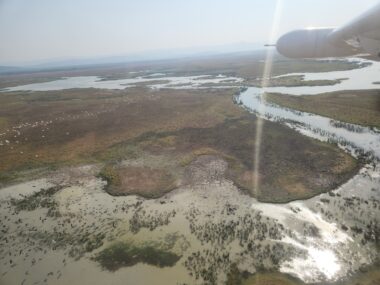Australian-led GALAH project releases the chemical fingerprints for almost 1,000,000 stars on the 50thbirthday of the AAT, Australia’s largest optical telescope.
Images: night and day at Australia's largest optical telescope, rainbow star spectra. Media pack including video and photos available (see below)
Australian scientists have released data from a massive, stellar mapping survey that has analysed nearly 1 million stars in the Milky Way. The data will form the basis for decades of research into the origins and development of our galaxy, as well as providing a valuable training set for the next generation of huge artificial intelligence-driven astronomical surveys.
The dataset, the pinnacle of 10 years’ work, was gathered by astronomers from Australia’s ARC Centre of Excellence in All Sky Astrophysics in 3 Dimensions (ASTRO 3D) using the Anglo-Australian Telescope (AAT) near Coonabarabran in NSW, itself celebrating 50 years of operation this week.

“Our work is focused on collecting as much quality data as we can,” said ASTRO 3D’s Sven Buder, a research fellow at the Australian National University.
“GALAH has shown us which chemical elements make up the stars of the Milky Way. This dataset now helps further our ability to accurately age the stars in our neighbourhood and understand where they came from.
“This data becomes a powerful tool for astronomers to test new theories and make new scientific discoveries about the Universe.”
The release is the fourth from the Galactic Archaeology with HERMES (GALAH) project, which has for 10 years been investigating star formation, chemical enrichment, migration and mergers in the Milky Way.
Previous GALAH data releases have fuelled a raft of significant discoveries regarding the evolution of the Milky Way, the existence of exo-planets, hidden star clusters, and many more.
The mapping survey, which made 1.08 million observations of 920,000 stars over 684 nights, uses an Australian instrument called the High Efficiency and Resolution Multi-Element Spectrograph, or HERMES, which is connected to the AAT.
“We have measured the elements within these stars, like carbon, nitrogen, oxygen, as well as heavy elements found in our smartphones and electric vehicles,” explained Dr Buder.
“This data will help us figure out how these elements are produced in stars, which is fundamental to explaining the origins of the building blocks of life.”
The data collected from the stars appears almost like ‘stellar rainbows’ – overlapping barcodes that when analysed can show the chemical composition of the stars. This can help us understand how elements are formed and distributed in the universe, as well as for potentially detecting signatures of planetary systems around the stars.
GALAH datasets are keenly awaited by the global astronomical community with 290 scientific studies using GALAH data to date. The previous data release paper, covering 300,000 stars, with more than 400 citations is the most cited work of the year in the journal that it was published in.
The GALAH data has in the past shown how stars may have consumed planets as the Milky Way developed.
“The GALAH survey has detected signs that some stars may have ‘eaten’ planets that were orbiting them,” said Professor Daniel Zucker of Macquarie University. “This can be observed by looking at the chemical composition of the star, as the elements from the consumed planet would show up as markers in the star's spectrum.”
Beyond the immediate scientific insights, the GALAH dataset will serve as a valuable training set for the next generation of artificial intelligence tools in astronomy. As the field increasingly relies on machine learning to analyse vast datasets, this Australian-led survey is helping to lay the groundwork for the future of the discipline around the world.
“Australia is leading the pack for the future of all of astronomy looking to tackle Big Data,” said Professor Zucker. “This dataset will serve as a one of the leading textbooks for training these AIs.”
Associate Professor Sarah Martell of UNSW, a key member of the project, said she was excited by what astronomers around the world could do with the data.
“We are really looking towards an incredibly exciting period over the next few years where all of these discoveries about what’s happening in our Universe are going to flow from the data that we've collected right here in Australia using Australian telescopes and building on Australian research.”
More than 100 scientists collaborate on the GALAH project. They are based at universities in Australia, Italy, UK, Slovenia, US, Hungary, Sweden, the Netherlands, and Germany.
Professor Emma Ryan-Weber, the Director of ASTRO 3D, said that GALAH and the research the survey enables directly speaks to ASTRO 3D’s mission.
“It helps us understand how galaxies build mass over time,” says Professor Ryan-Weber. “The chemical information the research team has gathered is like stellar DNA – we can use it to tell where each star has come from. We can also determine their ages and movements and gain a deeper understanding of how the Milky Way and other galaxies formed and have evolved.
“What’s more, as the ASTRO 3D mission comes to a close, the GALAH project will leave a lasting legacy of Australian science informing astronomical discoveries about the Universe’s origins and development for decades to come.”
The GALAH DR4 dataset can be found here.
About us:
About ASTRO 3D:
ASTRO 3D is a seven-year $40 million Centre of Excellence project funded by the Australian Government through the Australian Research Council. The Centre began in June 2017 and will end in June 2024. It hosts around 200 investigators and professional staff, mostly based at six nodes: the Australian National University, Curtin University, Swinburne University of Technology, University of Melbourne, University of Sydney, and University of Western Australia.
Contact details:
A full media pack including photos, images, video and animations along with a copy of the manuscript describing the data, is available at scienceinpublic.com.au/astro-3d
For password access and to coordinate interviews with study authors, please contact:
Tom Carruthers (for ASTRO 3D): [email protected] | +61 404 404 026 (UTC+10)
--
The GALAH Survey: Data Release 4
Contributing authors: S. Buder,1,2,3 J. Kos,4 E. X. Wang,1,2 M. McKenzie,1,2 M. Howell,5,2 S. L. Martell,6,2,7 M. R. Hayden,8,2 D. B. Zucker,9,10,2 T. Nordlander,1,2 B. T. Montet,6,2,7 G. Traven,4 J. Bland-Hawthorn,8,2 G. M. De Silva,10 K. C. Freeman,1,2 G. F. Lewis,8 K. Lind,11 S. Sharma,12 J. D. Simpson,6,2 D. Stello,6,8,2,13 T. Zwitter,4 A. M. Amarsi,14 K. Banks,6,2 K. Beeson,4 B. Chen,1,2 I. Ciucă,1,2 G. S. Da Costa,1,2 R. de Grijs,15,16,17 B. Martin,1 D. M. Nataf,18 M. K. Ness,1,2 A. Rains,19T. Scarr,1 R. Vogrinčič,4 Z. Wang,8,2,20 Y. Xie,1,2 and The GALAH Collaboration21
Institutions:
- Research School of Astronomy and Astrophysics, Australian National University, Canberra, ACT 2611, Australia
- ARC Centre of Excellence for All Sky Astrophysics in 3 Dimensions (ASTRO 3D), Australia
- ACCESS-NRI, Australian National University, Canberra, ACT2601, Australia
- Faculty of Mathematics & Physics, University of Ljubljana, Jadranska 19, 1000 Ljubljana, Slovenia
- School of Physics and Astronomy, Monash University, Clayton, VIC 3800, Australia
- School of Physics, UNSW, Sydney, NSW 2052, Australia
- UNSW Data Science Hub, University of New South Wales, Sydney, NSW 2052, Australia
- Sydney Institute for Astronomy, School of Physics, A28, The University of Sydney, NSW 2006, Australia
- School of Mathematical and Physical Sciences, Macquarie University, Sydney, NSW 2109, Australia
- Macquarie University Research Centre for Astronomy, Astrophysics and Astrophotonics, Sydney, NSW 2109, Australia
- Department of Astronomy, Stockholm University, AlbaNova University Centre, SE-106 91 Stockholm, Sweden
- Space Telescope Science Institute, 3700 San Martin Drive, Baltimore, MD, 21218, USA
- Stellar Astrophysics Centre, Aarhus University, Ny Munkegade 120, DK-8000 Aarhus C, Denmark
- Theoretical Astrophysics, Department of Physics and Astronomy, Uppsala University, Box 516, 751 20 Uppsala, Sweden
- School of Mathematical and Physical Sciences, Macquarie University, Balaclava Road, Sydney, NSW 2109, Australia
- Astrophysics and Space Technologies Research Centre, Macquarie University, Balaclava Road, Sydney, NSW 2109, Australia
- International Space Science Institute-Beijing, 1 Nanertiao, Zhongguancun, Beijing 100190, China
- Department of Physics & Astronomy, University of Iowa, Iowa City, IA 52242, USA
- Department of Physics and Astronomy, Uppsala University, Box 516, SE-75120 Uppsala, Sweden
- Department of Physics and Astronomy, University of Utah, Salt Lake City, UT 84112, USA
- https://www.galah-survey.org
Abstract
The stars of the Milky Way carry the chemical history of our Galaxy within their atmospheres as they journey through its vast expanse. Like barcodes, we can extract the chemical fingerprints of stars from high-resolution spectroscopy. The fourth data release (DR4) of the Galactic Archaeology with HERMES (GALAH) Survey, based on a decade of observations, provides the chemical abundances of up to 31 elements for 917 588 stars that also have exquisite astrometric data from the Gaia satellite. For the first time, these elements include life-essential nitrogen to complement carbon, and oxygen (CNO) and more measurements of rare earth elements critical to modern life electronics, offering unparalleled insights into the chemical composition of the Milky Way.
For this data release, we employ neural networks to simultaneously fit stellar parameters and chemical abundances across the full spectrum, leveraging synthetic grids computed with Spectroscopy Made Easy. The grids include atomic line formation in non-local thermodynamic equilibrium (NLTE) for 14 elements. In a two-iteration process, we first fit stellar labels for all 1 085 520 spectra, then co-add repeat spectra and refine these labels using astrometric data from Gaia and 2MASS photometry to deliver improved accuracy and precision. Our validation thoroughly assesses the reliability of these measurements and highlights key caveats for catalogue users.
GALAH DR4 represents yet another milestone in Galactic archaeology, combining detailed chemical compositions from multiple nucleosynthetic channels with kinematic information and age estimates. The resulting dataset, covering nearly a million stars, opens new avenues for understanding not only the chemical and dynamical history of the Milky Way, but also the broader questions of the origin of elements and the evolution of planets, stars, and galaxies.
Keywords: Surveys; theGalaxy; methods:observational; methods:dataanalysis; stars:fundamentalparameters; stars:abundances



